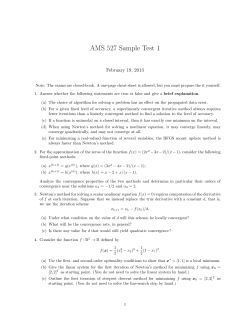
Exercise 3
Parallel Solution of Large Sparse Linear Systems, SS 2015
Prof. Dr. Peter Bastian, Marian Piatkowski
IWR, Universit¨at Heidelberg
Exercise sheet 3
Deadline 1st June 2015
E XERCISE 6 T HE PARALLEL R ICHARDSON ITERATION
We want to solve the linear system Ax “ b with the Richardson iteration
xpk`1q “ xpkq ` ωpb ´ Axpkq q.
Let A be the stiffness matrix coming from the discretization of the Poisson equation on the unitsquare
with P1 Finite Elements. We use a structured simplicial mesh with N “ n2 degrees of freedom.
To accelerate the computational time we want to do the iteration in parallel with p processors.
Therefore we subdivide the unitsquare into p smaller squares and the degrees of freedom are distributed accordingly. With this partitioning we assume that p is a square number such that every
?
processor has pn{ pq2 degrees of freedom. The index set of the degrees of freedom is denoted by I,
the index set of the i-th processor by Ii . Every processor stores the entries of xpkq corresponding to its
degrees of freedom and relevant rows of A.
One iteration of the parallel Richardson iteration consists of the following steps:
• Communication of required entries of xpkq from the neighbouring processors.
• Calculation of xpk`1q .
1. Describe the index sets Ii and specify which entries of xpkq the processor i has to communicate
with which processor.
2. The computation time for an arbitrary arithmetic operation (addition, subtraction or multiplication) is denoted by top , the time needed for sending one byte to another processor by tbyte
and the time needed to set up a message to another processor is denoted by tmsg .
Derive a formula for the total computational time of one iteration with p processors. The entries
of xpkq are stored in double precision such that every entry requires 8 byte of memory.
The formula has to be only asymptotically correct. The matrix rows of the nodes next to the
boundary which have less entries can be considered as interiour nodes.
3. Present the speedup of the parallel iteration in a table using the following parameters:
top “ 2 ns
tbyte “ 20 ns
tmsg “ 5000 ns
n P t1024, 4096u
p P t1, 4, 16, 256, 4096u
12 Points
E XERCISE 7 D OMAIN DECOMPOSITION
In the lecture you have learned the following theorem:
Let Ω Ă Rd be Lipschitz domain (open, bounded and connected) and let f P L2 pΩq. Then the Poisson
problem
´∆upxq “ f pxq @x P Ω
(1)
upxq “ 0
@x P BΩ
is equivalent to the solution of the two subproblems
´∆u1 pxq “ f pxq
@x P Ω1
u1 pxq “ 0
@x P BΩ1 zΓ
u1 pxq “ u2 pxq
Bu2 pxq
Bu1 pxq
“´
Bn1
Bn2
´∆u2 pxq “ f pxq
u2 pxq “ 0
@x P Γ
(2)
@x P Γ
@x P Ω2
@x P BΩ2 zΓ
with the non-overlapping decomposition
Ω “ Ω1 Y Ω2 ,
Ω1 X Ω2 “ H,
Γ “ BΩ1 X BΩ2 ,
µpBΩi q ą 0,
such that the BΩi are Lipschitz continuous.
The theory for the Poisson equation can be formulated for right-hand sides f P H ´1 pΩq as well.
But for the general assumption f P H ´1 pΩq, the equivalence (1) ô (2) does not hold. To see this we
are going to consider the following counter example in one dimension for Ω “ p´1, 1q:
´∆upxq “ ´2δpxq
in Ω
up´1q “ up1q “ 0
where δpxq denotes the Dirac delta function.
1. Find the unique weak solution u P H 1 pΩq.
2. What are the transmission conditions of upxq on Γ? Compare them to the transmissions conditions given in (2).
3. What changes in the derivation for the transmission conditions if we take again a right-hand
side f P L2 pΩq? Hint: Cauchy-Schwarz inequality.
8 Points
© Copyright 2025










